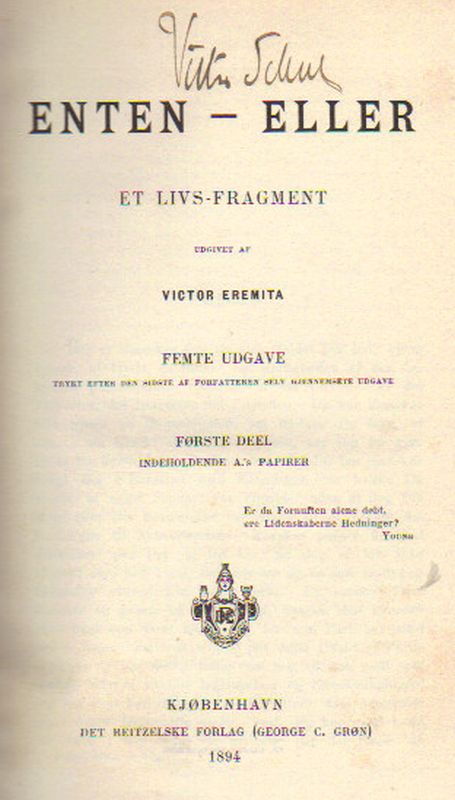[Kierkegaard, Enten-Eller. Et Lives-Fragment.
Enten-Eller. Et Lives-Fragment. Femte Udgave.
Kjobenhavn, George C. Gron, 1894. 20.7cm x 13.2cm. XVIII, 414 pages. Frontispiece portrait of Søren Kierkegaard. Original Hardcover (Halfleather with gilt lettering on spine) in protective Mylar. Very good condition with only minor signs of wear. Minor traces of foxing to endpapers. Text itself in excellent condition.
Published in two volumes in 1843, Either/Or (original Danish title: Enten – Eller) is an influential book written by the Danish philosopher Søren Kierkegaard, exploring the aesthetic and ethical “phases” or “stages” of existence. Either/Or was Kierkegaard’s first published book; it was released under the pseudonym Victor Eremita, Latin for “the victorious hermit”.
Either/Or portrays two life views, one consciously hedonistic, the other based on ethical duty and responsibility. Each life view is written and represented by a fictional pseudonymous author, with the prose of the work reflecting and depending on the life view being discussed. For example, the aesthetic life view is written in short essay form, with poetic imagery and allusions, discussing aesthetic topics such as music, seduction, drama, and beauty. The ethical life view is written as two long letters, with a more argumentative and restrained prose, discussing moral responsibility, critical reflection, and marriage. The views of the book are not neatly summarized, but are expressed as lived experiences embodied by the pseudonymous authors. The book’s central concern is the primal question asked by Aristotle, “How should we live?” His motto comes from Plutarch, “The deceived is wiser than one not deceived.”
The aesthetic is the personal, subjective realm of existence, where an individual lives and extracts pleasure from life only for his or her own sake. In this realm, one has the possibility of the highest as well as the lowest. The ethical, on the other hand, is the civic realm of existence, where one’s value and identity are judged and at times superseded by the objective world. In simple terms, one can choose either to remain oblivious to all that goes on in the world, or to become involved. More specifically, the ethic realm starts with a conscious effort to choose one’s life, with a choice to choose. Either way, however, an individual can go too far in these realms and lose sight of his or her true self. Only faith can rescue the individual from these two opposing realms. Either/Or concludes with a brief sermon hinting at the nature of the religious sphere of existence, which Kierkegaard spent most of his publishing career expounding upon. Ultimately, Kierkegaard’s challenge is for the reader to “discover a second face hidden behind the one you see” in him/herself first, and then in others:
″The Middle Ages are altogether impregnated with the idea of representation, partly conscious, partly unconscious; the total is represented by the single individual, yet in such a way that it is only a single aspect which is determined as totality, and which now appears in a single individual, who is because of this, both more and less than an individual. By the side of this individual there stands another individual, who, likewise, totally represents another aspect of life’s content, such as the knight and the scholastic, the ecclesiastic and the layman.” Either/Or Part I p. 86-87 Swenson. (Wikipedia)
- Keywords: Philosophy Rare
- Language: Danish
- Inventory Number: 40965AB
EUR 105,--
© 2025 Inanna Rare Books Ltd. | Powered by HESCOM-Software










